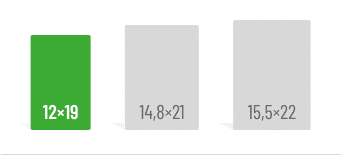First things first:
- The blurb is an advertisement for your book.
- Blurbs should be short and concise and not anticipate anything.
- Write your blurb with your target audience in mind.
Academic papers often begin with an abstract, which briefly summarizes the work and its findings, giving readers a general overview of the research question and methodology. However, you should never confuse this summary with the blurb: the blurb appears on the back cover of the printed version of your work and is the first thing potential readers see alongside the cover in the online version. For books with a dust jacket, the blurb is typically found on the second outer flap of the jacket. The purpose of the blurb is fundamentally different from that of the abstract. Why should you dedicate some time to crafting your blurb, and how can you make it shine? We’ve summarized the essentials for you here.
Why is a good blurb so important?
The blurb, alongside the title and cover, serves as the calling card for your book. After the cover, it’s the first thing potential buyers look at—and that’s why it’s so important. Awkwardly worded, dull, overly long, or error-ridden blurbs can quickly turn interested readers away and make them decide against purchasing your book.
The blurb is an advertisement. It should spark curiosity and encourage the reader to buy your book while also offering a glimpse into your writing style. Take the time to craft this text—it’s worth the effort!
How to nail your blurb: 5 tips
1. Of Avoiding Jargon and Bureaucratic Language: Write Clearly!
Many authors tend to fill their blurbs with the same technical terms they use in their work. This is understandable—after spending weeks, months, or even years (in the case of a dissertation) immersed in a subject, such terminology becomes second nature. However, you can’t always assume that your readers will immediately understand these terms. For your blurb, stick to simple wording and avoid jargon. Keep in mind that this short promotional text is meant to appeal to a broad audience: long, complex sentences and awkward passive constructions have no place here.
Avoid the passive voice by using instead of “In this work it is shown that…” rather write: “This thesis deals with…”.
You can easily paraphrase technical terms or simplify an issue that you will discuss in much more detail in the actual paper.
And in any case, avoid puns like this nested sentence:
“It’s hard to deny that long sentences can possess a certain beauty, offering a rhythm and melody that shorter sentences often lack. However, I am convinced that if one long sentence follows another, eventually no reader—no matter how interested—will truly enjoy finishing these intricate word constructions, woven line by line. With every additional clause, whether appended or interwoven, the fear grows that the thought being conveyed, no matter how true or beautiful, might never come to an end.”
2. Of subjunctives and typos: Every word counts!
A blurb, alongside the cover, is the first point of contact with potential readers, which means it needs to be flawless. Every typo or spelling mistake can cost you buyers and leave a poor impression.
In times of digitization and increased media consumption, our average attention span continues to decrease. You only have a few seconds to pique the interest of your readers. Therefore, be mindful of your words. Two to three short paragraphs are enough. Formulations that are well suited in an introduction (in the present work; in the following; in chapter 3 etc.) are superfluous and space-consuming for blurbs. You should avoid empty phrases, filler words and repetitions completely and only use adjectives where they are necessary. Subjunctives seem non-committal and vague. Instead of “This thesis tries to find an answer to the question”, write rather: “This thesis investigates [subject]”.
3. Of summaries and spoilers: Don’t anticipate anything!
Would you buy a crime novel whose blurb tells you the murderer?
The blurb is not a summary of your work, nor should it reveal the results of your study. Quite the opposite: you want to spark curiosity! Pose questions that your work answers and provide a general overview of the topic, but don’t give away too much.
4. Of digressions and attention to detail: Stay on topic!
Details and tangents add depth to your work but often distract from the main topic in a blurb — the very topic that should entice readers to purchase your book. Hints, however, are certainly allowed: Does your paper on coaching also explore the benefits of online coaching? Does your study on animal-assisted therapy include a discussion of particularly suitable dog breeds? Feel free to tease these aspects!
5. Of stylistic inconsistencies and misleading: Know your target group!
The blurb for a fiction novel is fundamentally different from that of an academic work. Make sure your text matches your genre: whimsical wordplay is as unsuitable for a scholarly book as suspenseful or humorous phrasing.
You should also be aware of your specific target group. Are you addressing advanced students, beginners, or a broad audience with your text? What prior knowledge can you assume, and where might you need to add an explanatory sentence? If you’re unsure who your target audience is, browse similar works — blurbs often explicitly state who the book is particularly suited for.
You might also be interested in these articles:
How is a good blurb structured?
A good blurb is well-structured and concise. Aim for two to three paragraphs, ensuring the total length does not exceed 200 words or 1,500 characters.
For the first paragraph, an introduction to the topic is a good idea: Why is your question topical or particularly interesting? What is the overarching problem that your work will solve?
In the second paragraph, you can get more specific: What is the work about, exactly? This is a great place to include your research questions or hypotheses.
The third paragraph outlines the specific aim of your work and provides a brief overview of the main thread it follows. You don’t need to explain the scientific methods you used here. It’s more effective to give your readers a final incentive to purchase your book: Does your work offer practical recommendations? Do your findings help readers improve their daily lives? Have you developed a new theory that could steer research in a new direction? At the very end of your blurb, you are welcome to name your target group: Who exactly is your work aimed at and for whom else could it be interesting?
The GRIN team wishes you the best of luck in writing your own blurb! If you need assistance, you can also enlist our experienced editorial team to craft a promotional text tailored specifically to your book through our Premium Services. Simply email us at premium@grin.com.
Do you like our magazine? Then sign up for our GRIN newsletter now!









